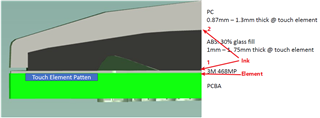Hello,
I am working on a design with very long curved slider elements. We are having some issues with our mechanical layer-stack dramatically decreasing sensitivity. We are going through the process of optimizing the materials, thickness, and eliminating air gaps.
During this process our OEM suggested that we use conductive ink as their other customers have to improve performance. My immediate response was no. But there seems to be some conflicting information on your design guide I would like some clarification on.
In your example of a typical stack-up you indicate that the stack-up should be non conductive which makes sense. As a conductive material in the stack-up will act as a shield if grounded, or a floating unknown capacitance if left floating, and potentially something in between. See link below:
Then you mention the use a conductive foam as a bridging material just a couple sections later. I am familiar with the concept of using a conductive bridge to basically extend a single cap-touch element away from the PCBA. i.e. adding a single spring to a single button. This makes sense to me as it is just acting as an extension of a single capacitive interaction between your finger and the pad. By the same token a conductive foam would server the same purpose.
My question is that when you move to a slider, does a conductive foam laid over all 4 elements act more as a shield than a conductive extension? Would each slider element need a separate piece of foam?
This leads me to my real question here, of will adding a conductive paint to the back side of a piece of ABS that is adhered our PCB via 3M 468MP help or hurt our touch slider?




